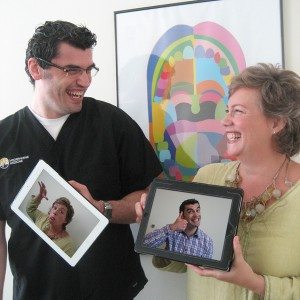Milestones in Medicine – Using iPads to Change the Game of Healthcare
 Up until a few years ago, each patient visit to the doctor required medical and administrative staff to juggle folders full of paper forms, doctor’s notes and test results. While paper is portable and inexpensive, the downsides – including illegible handwriting, filing errors and security issues – wear thin on busy practices trying to improve efficiency and profitability.
Up until a few years ago, each patient visit to the doctor required medical and administrative staff to juggle folders full of paper forms, doctor’s notes and test results. While paper is portable and inexpensive, the downsides – including illegible handwriting, filing errors and security issues – wear thin on busy practices trying to improve efficiency and profitability.
As a result, computers have become critical pieces of equipment in every medical practice. With government incentives, online prescription services, centralized records and lower prices for computers, electronic health record (EHR) systems are steadily replacing traditional paper systems. With the right EHR system like Modernizing Medicine’s Electronic Medical Assistant® (EMA ), medical practices are more organized and enjoy innovative tools to streamline practice workflow.
), medical practices are more organized and enjoy innovative tools to streamline practice workflow.
Yet, despite these advances, EHR systems bring challenges of their own. Entering information directly into a computer during a patient visit can be awkward and slow, and can take away a practitioner’s attention from the patient. In response, many doctors gather visit information throughout the day on paper and spend hours entering data into their EHR system at the end of the day when they could see more patients or spend time at home with their families. Clearly, improvements in patient experience and time management are needed. The smaller, light laptops and tablets help, but it’s the iPad that is truly changing the game for healthcare.
Delivering the ideal combination of convenience, comfort and power, iPads are quickly becoming the must-have device of healthcare providers. Let’s review how the iPad has become such a force for change.
Portability: Carry it everywhere, from exam room to the operating room, at home, on a plane, in a hotel, even in the bathroom. Not only does this mean that doctors can tend to business anywhere and at any time, it also means always available access to professional and peer resources to guide patient care.
- The right form factor: It’s small enough and light enough to hold in one hand and still enable the physician to face the patient while recording medical data. Using iPads to enter medical data during a patient visit seems natural for practitioners and patients. Since iPads are so popular with consumers, using one during a medical exam can breed easy familiarity and fascination with patients instead of building distance. Elegant application design and smaller screen sizing further help to streamline a doctor’s focus and workflow, versus a larger-format application with dozens of widgets.
- Touch-based interaction: Interactive interfaces designed just for medical professionals take the tedium out of typing. Dynamic multi-touch EHR screens require vastly less time to record visit information and are smart enough to do it in meaningful ways.
- Not just a different medium: iPads and apps make possible things that simply couldn’t be done before. Streaming patient education videos, obtaining patient consents electronically, touchpad drawing to illustrate explanations to patients, taking high-quality pictures of treatment sites with the built-in camera, and so much more…
EMA’s native iPad app has delivered on Dr. Gilbert Wong of Canyon Eye Center’s expectations. “The iPad makes it easier for me to be face to face with patients and enjoy a more mobile experience,” he noted. “With my previous EMR, it was inconvenient to lug around a laptop from room to room, or from a room to a table surface to use the mouse and keyboard to fill out charts. With EMA, I can fill out charts while I walk from room to room between patients.”
Accolades of the iPad aside, any new technology brings concerns. For medical professionals, security and the reliance on the Internet for access to mission-critical patient records rank high on their list of concerns.
With the iPad, the device itself and the apps that run on it have several layers of built-in security that guard against hacking and other types of unauthorized access, even when using public networking. This is a vital requirement for robust business applications such as EHR systems; patient information is heavily encrypted, and data transmission to hosting servers is secure, much like online banking and secure online purchases. Read more on iPad security.
We live in a world where good-quality wireless Internet access is almost ubiquitous and often times free. Even when Wi-Fi goes down or is unavailable, the built-in cellular service on the iPad takes over seamlessly. Unless practicing medicine in extremely remote areas with little or no cellular service, this extra level of connectivity service means ongoing productivity from just about anywhere.
Continues Dr. Wong: “Ophthalmology is a very visual medical specialty,” he continued. “With EMA, I can draw findings on the retina directly on the iPad, and the drawing is automatically included in the patient’s record. EMA and the iPad have also improved my interaction with my patients by allowing me to face them at all times. Electronic prescriptions are sent right through the app. I have one iPad for myself, and one for my tech. My staff loves the program.”
Like other major technology innovations that have changed the face of transportation, communications, and education, iPad-based EHR systems will continue to improve how medicine is practiced, for both patients and practitioners.